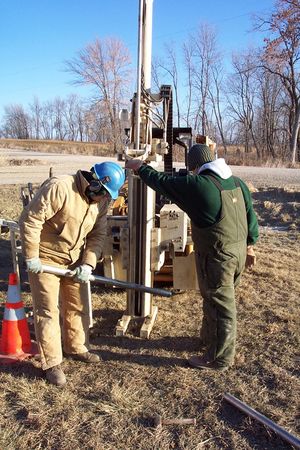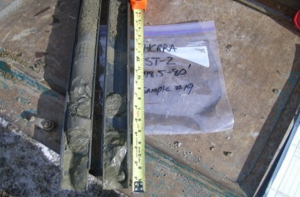 For stormwater infiltration best management practices (BMPs),
understanding your soil prior to designing and constructing the practice is
critical to the performance of the BMP. Many BMPs fail or do not achieve their
desired level of performance because soils were not properly investigated. The
following recommendations will help reduce the risk of failure due to poor
design or construction.
For stormwater infiltration best management practices (BMPs),
understanding your soil prior to designing and constructing the practice is
critical to the performance of the BMP. Many BMPs fail or do not achieve their
desired level of performance because soils were not properly investigated. The
following recommendations will help reduce the risk of failure due to poor
design or construction.
1.
Take enough samples. The Minnesota Stormwater
Manual recommends one boring for BMPs less than 1000 ft2 in area and
a boring for each additional 5000 ft2 in area. This is the minimum
number of samples. Before taking borings, review local soil maps and
depth-to-bedrock maps to determine likely variability in soils and bedrock
surface within the area (link
here for more information). Take additional borings if any of the following
conditions apply.
·
Multiple soil mapping units are likely to be
present
·
Bedrock is likely to be within 10 feet of the
surface
·
The seasonal high water table is likely to be
within 5 feet of the surface
·
The site location exhibits moderate or high topographic
relief
2.
Go deep enough. Borings should extend to a
minimum depth of 5 feet below the bottom of the infiltration practice. If
restrictive soil layers are likely to be encountered, extend borings to 10 feet
below the bottom of the infiltration practice.
3.
Understand what you are looking for.
Identification of low permeability or restrictive layers in soil is critical to
proper design and construction of infiltration practices. The presence of any
of the following may indicate the presence of a restrictive soil layer.
·
High clay content
·
Redoximorphic features
·
Change in particle size distribution
·
High blow counts
 Since even a very thin restrictive
layer in the soil profile will impede infiltration, the following are
recommended practices in collection borings.
Since even a very thin restrictive
layer in the soil profile will impede infiltration, the following are
recommended practices in collection borings.
·
If recovery in a split-spoon sample is
less than six inches, drill two feet deeper and perform another split-spoon
sample.
·
If a confining layer is found, or there
is low recovery in a split-spoon, reduce sampling intervals to every two feet.
Record the presence of the most restrictive layer, even if that material is not
the most abundant in the split-spoon sample.
·
If low recovery is encountered,
explain in the field notes why the driller thinks this is happening.
·
Record blow counts during a Standard Penetration
Test.
·
Include soil type, recovery, blow counts, and
presence of water in field logs.
Additional resources
1.
Guidance
on conducting soil borings – Minnesota Stormwater Manual